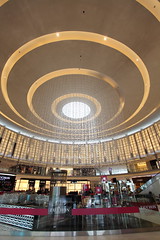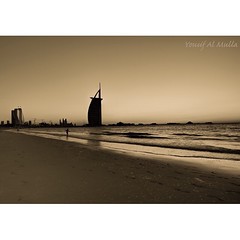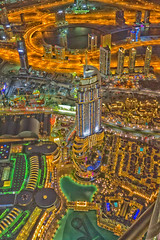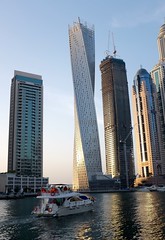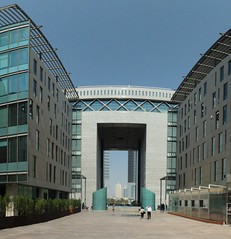 United Arab Emirates
United Arab Emirates
The United Arab Emirates (UAE; Arabic: اَلْإِمَارَات الْعَرَبِيَة الْمُتَحِدَة), or simply the Emirates (Arabic: الِْإمَارَات), is a country in Western Asia (the Middle East). It is located at the eastern end of the Arabian Peninsula and shares borders with Oman and Saudi Arabia, while having maritime borders in the Persian Gulf with Qatar and Iran. Abu Dhabi is the nation's capital, while Dubai, the most populated city, is an international hub.
The United Arab Emirates is an elective monarchy formed from a federation of seven emirates, consisting of Abu Dhabi (the capital), Ajman, Dubai, Fujairah, Ras Al Khaimah, Sharjah and Umm Al Quwain. Each emirate is governed by a ruler and together the rulers form the Federal Supreme Council. The members of the Federal Supreme Council elect a president (as of 14th May 2022, His Highness Sheikh Mohamed Bin Zayed Al Nahyan) and vice president (His Highness Sheikh Mohammed bin Rashid Al Maktoum) from among their members. In practice, the ruler of Abu Dhabi serves as president while the ruler of Dubai is vice president and also prime minister. In 2013, the country had a population of 9.2 million, of which 1.4 million were Emirati citizens and 7.8 million were expatriates. , the United Arab Emirates has an estimated population of roughly 9.9 million.
The area which is today the United Arab Emirates has been inhabited for over 125,000 years. It has been the crossroads of trading for many civilizations, including Mesopotamia, Persia, and India.
Islam is the official religion and Arabic is the official language. The United Arab Emirates' oil and natural gas reserves are the world's sixth and seventh-largest, respectively. Zayed bin Sultan Al Nahyan, ruler of Abu Dhabi and the country's first president, oversaw the development of the Emirates by investing oil revenues into healthcare, education, and infrastructure. The United Arab Emirates has the most diversified economy among the members of the Gulf Cooperation Council. In the 21st century, the country has become less reliant on oil and gas and is economically focusing on tourism and business. The government does not levy income tax, although there is a corporate tax in place and a 5% value-added tax was established in 2018.
Human rights groups, such as Amnesty International, Freedom House and Human Rights Watch, regard UAE as generally substandard on human rights, with citizens criticising the regime imprisoned and tortured, families harassed by the state security apparatus, and cases of forced disappearances. Individual rights such as the freedoms of assembly, association, the press, expression, and religion are also severely repressed.
The UAE is considered a middle power. It is a member of the United Nations, Arab League, Organisation of Islamic Cooperation, OPEC, Non-Aligned Movement, and Gulf Cooperation Council (GCC).
History
Human occupation in the region has been traced back to the emergence of anatomically modern humans from Africa circa 124,000 BCE through finds at the Faya-2 site in Mleiha, Sharjah. Burial sites dating back to the Neolithic Age and the Bronze Age include the oldest known such inland site at Jebel Buhais. Known as Magan to the Sumerians, the area was home to a prosperous Bronze Age trading culture during the Umm Al Nar period which traded between the Indus Valley, Bahrain and Mesopotamia as well as Iran, Bactria and the Levant. The ensuing Wadi Suq period and three Iron Ages saw the emergence of nomadism as well as the development of water management and irrigation systems supporting human settlement in both the coast and interior. The Islamic Age began with the expulsion of the Sasanians and the subsequent Battle of Dibba. The region's history of trade led to the emergence of Julfar, in the present-day emirate of Ras Al Khaimah, as a regional trading and maritime hub in the area. The maritime dominance of the Persian Gulf by Arab traders led to conflicts with European powers, including the Portuguese Empire and the British Empire.
Following decades of maritime conflict, the coastal emirates became known as the Trucial States with the signing of the General Maritime Treaty with the British in 1820 (ratified in 1853 and again in 1892), which established the Trucial States as a British protectorate. This arrangement ended with independence and the establishment of the United Arab Emirates on 2 December 1971 following the British withdrawal from its treaty obligations. Six emirates joined the UAE in 1971; the seventh, Ras Al Khaimah, joined the federation on 10 February 1972.
Antiquity
Stone tools recovered reveal a settlement of people from Africa some 127,000 years ago and a stone tool used for butchering animals discovered on the Arabian coast suggests an even older habitation from 130,000 years ago. There is no proof of contact with the outside world at that stage, although in time lively trading links developed with civilisations in Mesopotamia, Iran and the Harappan culture of the Indus Valley. This contact persisted and became wider, probably motivated by the trade in copper from the Hajar Mountains, which commenced around 3,000 BCE. Sumerian sources talk of the Magan civilisation, which has been identified as encompassing the modern UAE and Oman.
There are six periods of human settlement with distinctive behaviours in the region before Islam, which include the Hafit period from 3,200 to 2,600 BCE, the Umm Al Nar culture from 2,600 to 2,000 BCE, and the Wadi Suq culture from 2,000 to 1,300 BCE. From 1,200 BCE to the advent of Islam in Eastern Arabia, through three distinctive Iron Ages and the Mleiha period, the area was variously occupied by the Achaemenids and other forces, and saw the construction of fortified settlements and extensive husbandry thanks to the development of the ''falaj'' irrigation system.
In ancient times, Al Hasa (today's Eastern Province of Saudi Arabia) was part of Al Bahreyn and adjoined Greater Oman (today's UAE and Oman). From the second century CE, there was a movement of tribes from Al Bahreyn towards the lower Gulf, together with a migration among the Azdite Qahtani (or Yamani) and Quda'ah tribal groups from south-west Arabia towards central Oman.
Islam
The spread of Islam to the northeastern tip of the Arabian Peninsula is thought to have followed directly from a letter sent by the Islamic prophet, Muhammad, to the rulers of Oman in 630 CE, nine years after the hijrah. This led to a group of rulers travelling to Medina, converting to Islam and subsequently driving a successful uprising against the unpopular Sassanids, who dominated the coast at the time. Following the death of Muhammad, the new Islamic communities south of the Persian Gulf threatened to disintegrate, with insurrections against the Muslim leaders. Caliph Abu Bakr sent an army from the capital Medina which completed its reconquest of the territory (the Ridda Wars) with the Battle of Dibba in which 10,000 lives are thought to have been lost. This assured the integrity of the Caliphate and the unification of the Arabian Peninsula under the newly emerging Rashidun Caliphate.
In 637, Julfar (in the area of today's Ras Al Khaimah) was an important port that was used as a staging post for the Islamic invasion of the Sasanian Empire. The area of the Al Ain/Buraimi Oasis was known as Tu'am and was an important trading post for camel routes between the coast and the Arabian interior.
The earliest Christian site in the UAE was first discovered in the 1990s, an extensive monastic complex on what is now known as Sir Bani Yas Island and which dates back to the seventh century. Thought to be Nestorian and built in 600 CE, the church appears to have been abandoned peacefully in 750 CE. It forms a rare physical link to a legacy of Christianity, which is thought to have spread across the peninsula from 50 to 350 CE following trade routes. Certainly, by the fifth century, Oman had a bishop named John – the last bishop of Oman being Etienne, in 676 CE.
Portuguese era
The harsh desert environment led to the emergence of the "versatile tribesman", nomadic groups who subsisted due to a variety of economic activities, including animal husbandry, agriculture and hunting. The seasonal movements of these groups led not only to frequent clashes between groups but also to the establishment of seasonal and semi-seasonal settlements and centres. These formed tribal groupings whose names are still carried by modern Emiratis, including the Bani Yas and Al Bu Falah of Abu Dhabi, Al Ain, Liwa and the west coast, the Dhawahir, Awamir, Al Ali and Manasir of the interior, the Sharqiyin of the east coast and the Qawasim to the North.
With the expansion of European colonial empires, Portuguese, English and Dutch forces appeared in the Persian Gulf region. By the 18th century, the Bani Yas confederation was the dominant force in most of the area now known as Abu Dhabi, while the Northern Al Qawasim (Al Qasimi) dominated maritime commerce. The Portuguese maintained an influence over the coastal settlements, building forts in the wake of the bloody 16th-century conquests of coastal communities by Albuquerque and the Portuguese commanders who followed him – particularly on the east coast at Muscat, Sohar and Khor Fakkan.
The southern coast of the Persian Gulf was known to the British as the "Pirate Coast", as boats of the Al Qawasim federation harassed British-flagged shipping from the 17th century into the 19th. The charge of piracy is disputed by modern Emirati historians, including the current Ruler of Sharjah, Sheikh Sultan Al Qasimi, in his 1986 book The Myth of Arab Piracy in the Gulf.
British expeditions to protect their Indian trade routes led to campaigns against Ras Al Khaimah and other harbours along the coast, including the Persian Gulf campaign of 1809 and the more successful campaign of 1819. The following year, Britain and a number of local rulers signed a maritime truce, giving rise to the term Trucial States, which came to define the status …
Looking for places related to United Arab Emirates?
Those are other destinations to find places related to United Arab Emirates:





